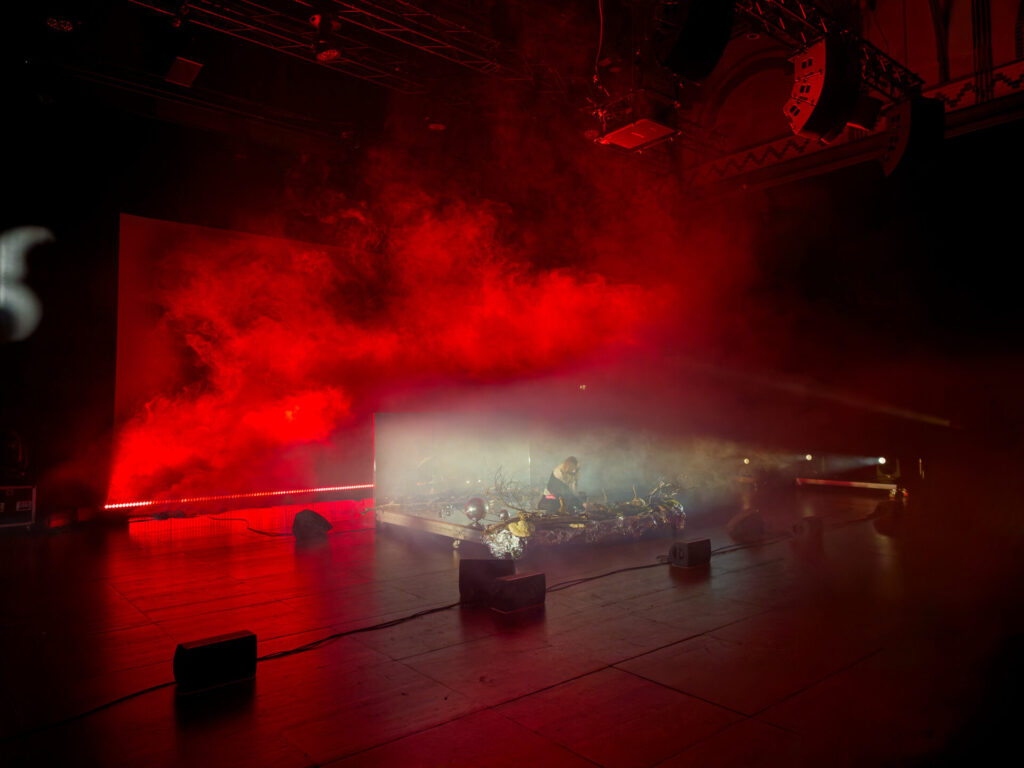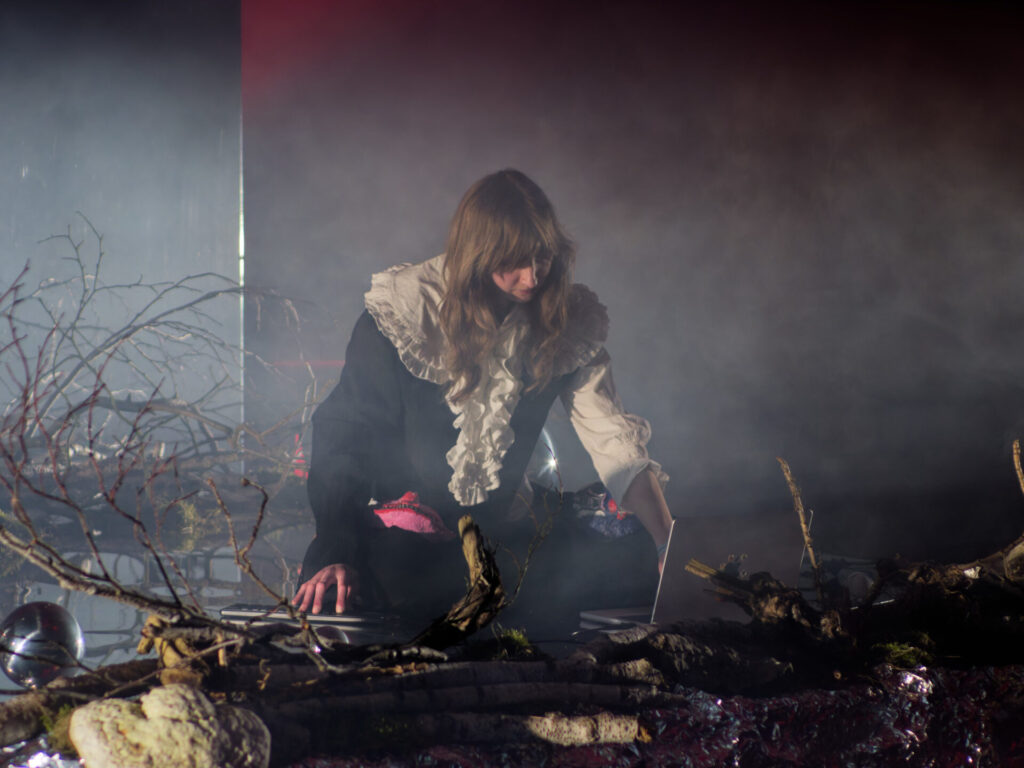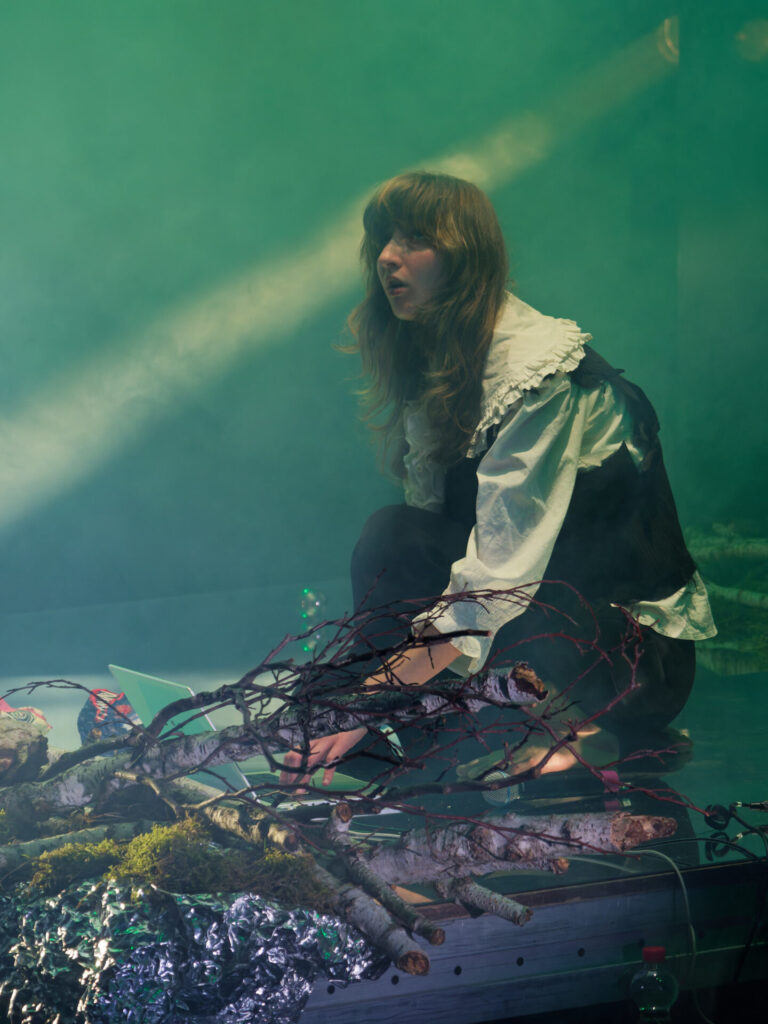In a Berlin hotel that feels like a cheap facsimile of the city’s soul – all curated grit and sanitised rebellion – Lénok reflects on the evening’s performance that was bookended by a torrent of tears and swell of body tremors. ”I think it’s normal, these kinds of shock responses,” she says, picking at the peeling wallpaper. “Back in The Hague, my life is just going to school, the library, and back home – on time, in a loop.”
Originally hailing from small-town Slovakia, Lénok began her search for expression in intermedia arts before she settled on the medium of sound as her primary focus, and is now studying Sonology at The Royal Conservatory in The Hague. When we speak on the phone before her performance, she is in her DAW (Digital Audio Workstation) “cleaning up the messes” – a phrase she offers with a kind of drowsy contentedness. She keeps a notepad near her bed to capture ideas that emerge in the uninhibited nocturnal imagination. It’s a state in which she opens up to what she calls “the ripening of billions of interconnections” as she seeks the means of “tearing off the threads with most resonance”.
The Berlin-based light and set designers Grinderteeth and Synthtati joined Lénok in the residency to find ways to visually echo her interweaving and fraying sound designs. Grinderteeth comments that “Lénok’s composition is full of contrasts – soaring, emotional strings and bells, cut into noise and distortion.” For her work, light is as Carl Jung described colour: “the mother tongue of our subconscious”. Translating the sound with Day-Glo yellows blending into smouldering reds, light becomes, as she puts it, “a core biome” of our emotional experience.
In the performance, the lights flicker like sticky eyelids waking from a heavy slumber. Glimpses can be caught of Lénok submerged in reflections and distortions of what Synthtati describes as “mirrored glass portals”. She says that the way Lénok uses electronics inspired her to mix organic and synthetic textures. “Often in these big productions, the focus is on complex lights, wires, and electronic technology, but I hope instead people can come closer to connect with these foraged materials and themselves feel a part of this microcosm.”
The stark industrial set acts as a blank canvas for the action to unfold. Lénok enters the scene only to gallop off immediately, as the composition begins with a field recording of a crowd leaving a castle. She speaks of the feeling of being left behind, where isolation heightens the listener’s sensitivity and draws them deeper into the narrative. “Even with everyone else there, it might feel like you’re experiencing this alone,” she says. Yet, she acknowledges the challenge of creating this immersive space: “These days, it’s harder to craft an experience that’s not virtual but truly live. You’re not wearing headphones to simulate something – you’re in a space where anything can happen.”
Synthtati describes virtual spaces as “completely absorbing, pulling you into a world where you can interact and observe,” while Grinderteeth laments on the difficulty of staying present, even in a dynamic production. She warns of the trap in treating such spaces as an easy path to involvement: “They simulate self-regulation and even mimic creative workflow, but this avoidance of confrontation comes at the expense of engaging with what’s right in front of you.” It’s these challenges of external overflow that Lénok seeks to reconcile through ‘deep listening’. She acknowledges that for some, even closing their eyes to focus can be a struggle – a difficulty she knows all too well, given her own dealings with sleep. Yet her response is resolute: “Eventually you have to go through things, whether you want to or not, and by attuning to the work, in a way, you’re facing it.”

The candid moment with the field recording is soon swallowed by a boisterous stream of mutating sounds, along with rising plumes of smoke that fill the vacant corners of the space. Lénok breaks the fourth wall to call out, “Hey!” Her tone is playful, like an RPG NPC inviting you on a quest, as she shyly asks, “I heard you left?” – perhaps even to someone already no longer there. She conjures what she calls “animalish-spirits,” their jovial cries bursting from the gurgling swampscape, swarming into a chorus before fragmenting back into murky excess. “There’s not always space to ground,” she warns. “The transmissions shift constantly, and we’re out of time – we’re in a spin.”
This sense of fragmentation and urgency mirrors the process of collaboration itself. With only days to meet, rehearse and perform, the production thrived on the tension between chaos and precision. “First you have to embrace the unexpectedness, to then find out how you can ‘go deep’ in the work,” Synthtati notes. Lénok, meanwhile, saw the tight timeline as a catalyst: “Everyone wishes for more time, but I wonder how different it could be? Because it’s pushing you, it forces you out of your mind a bit.” The result is a series of fleeting and intense vignettes in which the mess becomes the composition, and the constraints allow an authenticity that might otherwise be lost in overthinking.
This delirium, born from constraint, spills into the work itself, echoing the duality Lénok encountered when she first showed the masks later incorporated into the performance to a friend. With their sharp, accentuated teeth, they could easily seem unsettling or even horrifying, but to him, she explains, “they felt happy and joyful. I quickly realised, yes, it’s true – they have this smile.” This tension between horror and joy, mess and meaning, captures the slippery essence of the work. “It’s that weird moment,” she says, “when you feel so intensely, you don’t know if you’re lost or finding a deeper understanding within the feeling.” The performance, like the masks, thrives on this ambiguity.

Between structure and spontaneity Lénok finds herself reflecting on how “we’re becoming like these mechanisms internally – sophisticated, technical, numbered.” But to counter this, she focuses on the moments between her prepared intentions, especially when working with others. “Those unplanned interactions feel more authentic, more conversational,” she explains. “Sometimes, they shift the entire direction of the project because of something hidden in those recordings.”
For Lénok, this search makes the recordings not just material to recreate from but its own composition to compartmentalise. “I like reminiscing and trying to recall the feeling of something I found in what I heard,” she says, referring to a candid phone recording of her peers experimenting with pitch. In this recording, she’s struck by the tenderness of the moment, yet aware that any attempt to recreate it would fall short. “I know I’ll never be able to simulate something similar,” she admits, “but I still try to understand what makes it so intimate.”
Lénok is an artist of the SHAPE+ platform for innovative music and interdisciplinary art, co-funded by the EU and Pro Helvetia.


